

You Don't Have to Eat Carrageenan: Finding Alternatives to a Toxic Food Additive. Carrageenan is a common food additive extracted from red seaweed.

For the past four decades, scientists have warned that the use of carrageenan in food is not safe. Animal studies have repeatedly shown that food-grade carrageenan causes gastrointestinal inflammation and higher rates of intestinal lesions, ulcerations, and even malignant tumors. Despite the evidence showing the risks in eating carrageenan, it’s still approved for use in organic food where it’s most often used as a stabilizer. It’s an ingredient in many dairy products including ice cream, cheese, yogurt , sour cream, whipping cream and chocolate milk. You’ll also find it in nondairy milks including soy, almond, coconut and rice milk. You Don't Have to Eat Carrageenan: Finding Alternatives to a Toxic Food Additive. The ‘Horribly Mutated’ Seafood in The Gulf of Mexico. BP oil spill: The ‘horribly mutated’ creatures living in the Gulf.
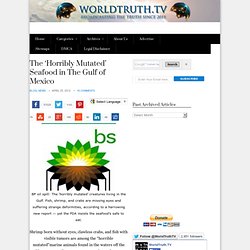
Fish, shrimp, and crabs are missing eyes and suffering strange deformities, according to a harrowing new report — yet the FDA insists the seafood’s safe to eat. Shrimp born without eyes, clawless crabs, and fish with visible tumors are among the “horrible mutated”marine animals found in the waters off the Gulf Coast, according to a new report from Al Jazeera. Scientists say the problem is a side effect of the April 2010 explosion of BP’s Deepwater Horizon oil rig, which killed 11 people and spilled at least 4.9 million barrels of oil into the ocean. Here, a brief guide to the damage: “The fishermen have never seen anything like this,” Dr Jim Cowan told Al Jazeera. Gulf of Mexico fishermen, scientists and seafood processors have told Al Jazeera they are finding disturbing numbers of mutated shrimp, crab and fish that they believe are deformed by chemicals released during BP’s 2010 oil disaster.
Gulf Seafood. By: Michael R.
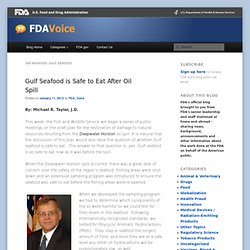
Taylor, J.D. This week, the Fish and Wildlife Service will begin a series of public meetings on the draft plan for the restoration of damage to natural resources resulting from the Deepwater Horizon oil spill. It is natural that the discussion of this plan would also raise the question of whether Gulf seafood is safe to eat. The answer to that question is, yes. Your Yogurt Has More Sugar Than A Coke (And Some Other Sneaky Food Stuff You Didn’t Know) How Bad Is Junk Food For Your DNA? Do Hidden Opiates In Our Food Explain Food Addictions?
By Sayer Ji Contributing Writer for Wake Up World Food addictions are not strictly “psychological” problems, but have a hard-wired, organic component.

Many of the most commonly consumed foods in Western culture actually contain narcotic properties associated with the presence of psychoactive chemicals that bind to opioid receptors in the nervous system. The Ultimate Craving - How Industry Designs Food to be as Addictive as Narcotics. By Carolanne Wright Contributing Writer for Wake Up World.
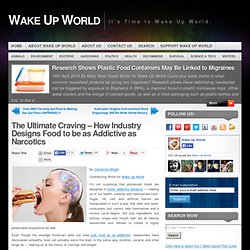
GMO – Genetically Modified Organisms. Brave New Medicated World: Free-Thinking and Non-Conformity Now “Illnesses” 4th April 2014.
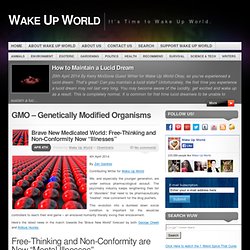
Not even good enough for dog food: Imported food from China loaded with chemicals, dyes, pesticides and fake ingredients. (NaturalNews) Do you really know what's in all the food you're eating that's imported from China?
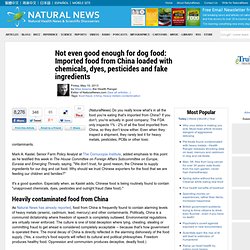
If you don't, you're actually in good company: The FDA only inspects 1% - 2% of all the food imported from China, so they don't know either. Even when they inspect a shipment, they rarely test it for heavy metals, pesticides, PCBs or other toxic contaminants. Sadly, this is too. China admits to existence of 'cancer villages' sprouting up due to extreme pollution, chemical exposure. (NaturalNews) On the heels of my own publication of articles questioning the integrity of "certified organic" when it comes to foods and superfoods produced in mainland China, a blockbuster report from China's own environmental ministry slams another exclamation mark on the severity of the problem.
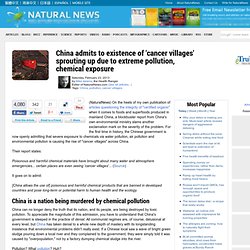
For the first time in history, the Chinese government is now openly admitting that severe exposure to chemicals via water pollution, air pollution and environmental pollution is causing the rise of "cancer villages" across China. Their report states: Poisonous and harmful chemical materials have brought about many water and atmosphere emergencies... certain places are even seeing 'cancer villages'... (Source) It goes on to admit: [China allows the use of] poisonous and harmful chemical products that are banned in developed countries and pose long-term or potential harm to human health and the ecology. A complete list of artificial ingredients. Superbugs in Canadian chicken? Yes, and US too.
CBC News, the Canadian national TV network, has caused a stir in the food-blog world with the results of a nationwide investigation that found antibiotic-resistant bacteria contaminating supermarket chicken.

In its words: Chicken bought at major supermarkets across Canada is frequently contaminated with superbugs — bacteria that many antibiotics cannot kill — an investigation by CBC TV’s Marketplace has found.Marketplace researchers — along with their colleagues at Radio-Canada’s food show L’Epicerie — bought 100 samples of chicken from major grocery chains in Vancouver, Toronto and Montreal… The 100 samples were sent to a lab for analysis.